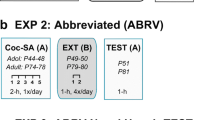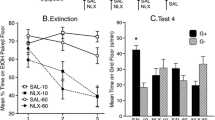Abstract
Rationale
Disruption of acquired drug–cue associations can effectively decrease relapse. The benefits of extinction training as opposed to abstinence have been reported. Timing of extinction trials is an important variable. Finding an effective extinction regimen can optimize addiction therapies.
Objective
To determine the effects of different drug-free periods on cocaine-conditioned place preference (CPP) in rats that either did or did not receive non-reinforced exposure to drug-associated stimuli.
Materials and methods
Male adolescent rats were trained for cocaine-CPP (5, 10, or 15 mg/kg, i.p.) in a biased manner for 8 days and then tested following different intervals.
Results
Rats treated with 15 mg/kg cocaine displayed high and equal CPP on the first test, performed 1, 4, 7, or 14 days following conditioning. Expression of CPP during the test performed 1 day after conditioning was equal in the groups conditioned with 5, 10, or 15 mg/kg cocaine. When the interval before the first test was extended to 14 days, the group treated with 5 mg/kg did not show CPP. Rats treated with the three doses and tested repeatedly at 1, 7, and 14 days did not display CPP on the third test. CPP after treatment with 10 or 15 mg/kg cocaine was already extinguished in the second test but only for an interval of 1–14 days.
Conclusions
Maintenance of CPP was evident at least 2 weeks after forced abstinence. Extinguished CPP can be obtained after a single extinction trial, performed close to original training and followed by prolonged abstinence. However, with low doses of cocaine, abstinence alone may be sufficient to disrupt drug–cue associations.






Similar content being viewed by others
References
Aberg M, Wade D, Wall E, Izenwasser S (2007) Effect of MDMA (ecstasy) on activity and cocaine conditioned place preference in adult and adolescent rats. Neurotoxicol Teratol 29:37–46
Badanich KA, Adler KJ, Kirstein CL (2006) Adolescents differ from adults in cocaine conditioned place preference and cocaine-induced dopamine in the nucleus accumbens septi. Eur J Pharmacol 550:95–106
Balda MA, Anderson KL, Itzhak Y (2006) Adolescent and adult responsiveness to the incentive value of cocaine reward in mice: role of neuronal nitric oxide synthase (nNOS) gene. Neuropharmacology 51:341–349
Bardo MT, Neisewander JL, Miller JS (1986) Repeated testing attenuates conditioned place preference with cocaine. Psychopharmacology (Berl) 89:239–243
Bardo MT, Rowlett JK, Harris MJ (1995) Conditioned place preference using opiate and stimulant drugs: a meta-analysis. Neurosci Biobehav Rev 19:39–51
Botreau F, Paolone G, Stewart J (2006) d-Cycloserine facilitates extinction of a cocaine-induced conditioned place preference. Behav Brain Res 172:173–178
Brenhouse HC, Andersen SL (2008) Delayed extinction and stronger reinstatement of cocaine conditioned place preference in adolescent rats, compared to adults. Behav Neurosci 122:460–465
Breslau N, Kilbey MM, Andreski P (1993) Vulnerability to psychopathology in nicotine-dependent smokers: an epidemiologic study of young adults. Am J Psychiatry 150:941–946
Calcagnetti DJ, Schechter MD (1993) Extinction of cocaine-induced place approach in rats: a validation of the “biased” conditioning procedure. Brain Res Bull 30:695–700
Calcagnetti DJ, Quatrella LA, Schechter MD (1996) Olfactory bulbectomy disrupts the expression of cocaine-induced conditioned place preference. Physiol Behav 59:597–604
Campbell JO, Wood RD, Spear LP (2000) Cocaine and morphine-induced place conditioning in adolescent and adult rats. Physiol Behav 68:487–493
Crombag HS, Bossert JM, Koya E, Shaham Y (2008) Review context-induced relapse to drug seeking: a review. Philos Trans R Soc Lond B Biol Sci 363:3233–3243
Di Ciano P, Everitt BJ (2002) Reinstatement and spontaneous recovery of cocaine-seeking following extinction and different durations of withdrawal. Behav Pharmacol 13:397–405
Doremus-Fitzwater TL, Varlinskaya EI, Spear LP (2010) Motivational systems in adolescence: possible implications for age differences in substance abuse and other risk-taking behaviors. Brain Cogn 72:114–123
Durazzo TC, Gauvin DV, Goulden KL, Briscoe RJ, Holloway FA (1994) Cocaine-induced conditioned place approach in rats: the role of dose and route of administration. Pharmacol Biochem Behav 49:1001–1005
Ellickson PL, Tucker JS, Klein DJ (2001) High-risk behaviors associated with early smoking: results from a 5-year follow-up. J Adolesc Health 28:465–473
Horan B, Gardner EL, Ashby CR Jr (2000) Enhancement of conditioned place preference response to cocaine in rats following subchronic administration of 3, 4-methylenedioxymethamphetamine (MDMA). Synapse 35:160–162
Kandel DB (1982) Epidemiological and psychosocial perspectives on adolescent drug use. J Am Acad Child Psychiatry 21:328–347
Kandel DB, Yamaguchi K, Chen K (1992) Stages of progression in drug involvement from adolescence to adulthood: further evidence for the gateway theory. J Stud Alcohol 53:447–457
Kelamangalath L, Wagner JJ (2009) Effects of abstinence or extinction on cocaine seeking as a function of withdrawal duration. Behav Pharmacol 20:195–203
Kelamangalath L, Swant J, Stramiello M, Wagner JJ (2007) The effects of extinction training in reducing the reinstatement of drug-seeking behavior: involvement of NMDA receptors. Behav Brain Res 185:119–128
Mueller D, De Wit H (2011) Conditioned place preference in rodents and humans. Neuromethods 50:133–152
Mueller D, Stewart J (2000) Cocaine-induced conditioned place preference: reinstatement by priming injections of cocaine after extinction. Behav Brain Res 115:39–47
Myers KM, Carlezon WA Jr (2010) Extinction of drug- and withdrawal-paired cues in animal models: relevance to the treatment of addiction. Neurosci Biobehav Rev 35:285–302
Nomikos GG, Spyraki C (1988) Cocaine-induced place conditioning: importance of route of administration and other procedural variables. Psychopharmacology (Berl) 94:119–125
O’Dell LE, Khroyan TV, Neisewander JL (1996) Dose-dependent characterization of the rewarding and stimulant properties of cocaine following intraperitoneal and intravenous administration in rats. Psychopharmacology (Berl) 123:144–153
Paolone G, Botreau F, Stewart J (2009) The facilitative effects of d-cycloserine on extinction of a cocaine-induced conditioned place preference can be long lasting and resistant to reinstatement. Psychopharmacology (Berl) 202:403–409
Reboussin BA, Anthony JC (2006) Is there epidemiological evidence to support the idea that a cocaine dependence syndrome emerges soon after onset of cocaine use? Neuropsychopharmacology 31:2055–2064
Robins LN, Przybeck TR (1985) Age of onset of drug use as a factor in drug and other disorders. NIDA Res Monogr 56:178–192
Schroeder JP, Packard MG (2003) Systemic or intra-amygdala injections of glucose facilitate memory consolidation for extinction of drug-induced conditioned reward. Eur J Neurosci 17:1482–1488
Thiel KJ, Engelhardt B, Hood LE, Peartree NA, Neisewander JL (2011) The interactive effects of environmental enrichment and extinction interventions in attenuating cue-elicited cocaine-seeking behavior in rats. Pharmacol Biochem Behav 97:595–602
Tirelli E, Laviola G, Adriani W (2003) Ontogenesis of behavioral sensitization and conditioned place preference induced by psychostimulants in laboratory rodents. Neurosci Biobehav Rev 27:163–178
Trujillo KA, Belluzzi JD, Stein L (1991) Naloxone blockade of amphetamine place preference conditioning. Psychopharmacology (Berl) 104:265–274
Tzschentke TM, Schmidt WJ (1995) N-methyl-d-aspartic acid-receptor antagonists block morphine-induced conditioned place preference in rats. Neurosci Lett 193:37–40
Zakharova E, Wade D, Izenwasser S (2009) Sensitivity to cocaine conditioned reward depends on sex and age. Pharmacol Biochem Behav 92:131–134
Acknowledgments
This research was supported by the Israel Science Foundation (grant no. 144/10) and the National Institute for Psychobiology in Israel founded by the Charles E. Smith family. R. Yaka is affiliated with the David R. Bloom Center for Pharmacy and the Brettler Center for Research in Molecular Pharmacology and Therapeutics, School of Pharmacy, The Hebrew University of Jerusalem. Dr. Poltyrev thanks the Israel Ministry of Absorption for financial support.
Author information
Authors and Affiliations
Corresponding author
Rights and permissions
About this article
Cite this article
Poltyrev, T., Yaka, R. Influence of abstinence and intervals between extinction trials on the expression of cocaine-conditioned place preference in adolescent rats. Psychopharmacology 226, 699–706 (2013). https://doi.org/10.1007/s00213-012-2720-2
Received:
Accepted:
Published:
Issue Date:
DOI: https://doi.org/10.1007/s00213-012-2720-2




